Inside The New York Botanical Garden
Ruth Rea Howell Family Garden
Posted in Programs and Events on May 10 2012, by Ann Novak
As the founder and director of the Growing Chefs field-to-fork education program, co-founder of the Eagle Street Rooftop Farm, and the Assistant Manager of the Ruth Rea Howell Family Garden, Annie Novak knows her way around a vegetable plot. Join her on May 17 for The Art of Cooking in the French Garden, bringing the taste and sophistication of this world-renowned cuisine to the NYBG.
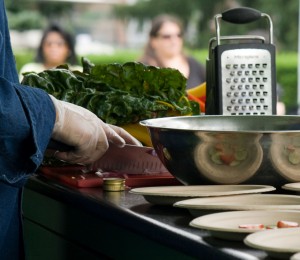 Coq au vin, Quiche Lorraine, and vichyssoise—nowhere in the world have culinary artists developed such a reputation for precision, passion and talent as in the French kitchen. From perfectly crusty baguettes to finely flavored vinaigrettes, the art of French cooking seems at first glance like an unachievable alchemy of herbs, creams, and knife skills. But as a green thumb enamored with the precise and beautiful public parks throughout Paris (and a compulsive Googler of Versailles’ vegetable gardens), I became obsessed with the idea that French food could be done well, yet with ease.
Coq au vin, Quiche Lorraine, and vichyssoise—nowhere in the world have culinary artists developed such a reputation for precision, passion and talent as in the French kitchen. From perfectly crusty baguettes to finely flavored vinaigrettes, the art of French cooking seems at first glance like an unachievable alchemy of herbs, creams, and knife skills. But as a green thumb enamored with the precise and beautiful public parks throughout Paris (and a compulsive Googler of Versailles’ vegetable gardens), I became obsessed with the idea that French food could be done well, yet with ease.
Read More
Posted in Around the Garden on May 8 2012, by Ann Novak
Ed. Note: The beekeeping craze that’s sweeping New York City isn’t just for rooftops in Brooklyn! Annie Novak, Assistant Manager of the Ruth Rea Howell Family Garden, was kind enough to explain her most recent adventure giving bees a home at the NYBG.
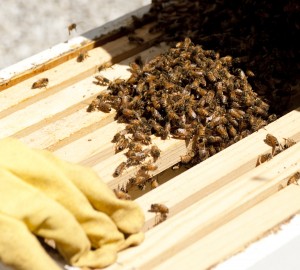 We installed the beehives on top of our garden shed space, so the bees have a clear flight path over the Garden site. As the hives’ populations grow, so do our vegetables. Thanks to the bees, we have higher rates of fruiting on our apple trees and pepper plants.
We installed the beehives on top of our garden shed space, so the bees have a clear flight path over the Garden site. As the hives’ populations grow, so do our vegetables. Thanks to the bees, we have higher rates of fruiting on our apple trees and pepper plants.
The bees spend the first part of the spring season building up wax combs to lay eggs in, as well as store honey later in the year. As the Family Garden grows, and the cherries and lilacs just outside the Family Garden bloom, we start to see our bees venture further afield. They’ll fly up to five miles from the hive to gather nectar and pollen, but with a campus as lush as the New York Botanical Garden, they don’t have to go that far to get food.
Read More
Posted in Programs and Events on May 1 2012, by Education at NYBG
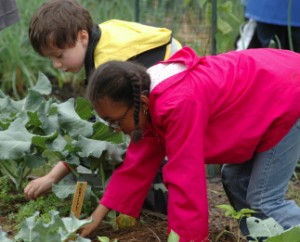 How often do your kids get a free pass to play in the dirt? It’s probably not a daily event. But beginning Wednesday, May 2, the NYBG kicks off children’s gardening programs at the Ruth Rea Howell Family Garden that won’t leave you scrubbing muddy footprints off the kitchen floor.
How often do your kids get a free pass to play in the dirt? It’s probably not a daily event. But beginning Wednesday, May 2, the NYBG kicks off children’s gardening programs at the Ruth Rea Howell Family Garden that won’t leave you scrubbing muddy footprints off the kitchen floor.
Garden Sprouts introduces three- to five-year-olds and their accompanying parent to garden exploration, from digging for earthworms to planting seeds. Sprouts enjoy seasonal gardening tasks, the opportunity to sample garden-fresh produce grown in their own plots, and activities especially crafted for the young green thumb. It’s a fun and productive way to get them out of the house.
Read More
Posted in Programs and Events on February 13 2012, by Matt Newman
 Especially because this winter feels like an early springtime, it’s time to get excited for a new season of the Children’s Gardening Program at the two-acre Ruth Rea Howell Family Garden. As of February 1, we opened registration for our popular Crafters and Sprouts for the spring, summer, and fall sessions.
Especially because this winter feels like an early springtime, it’s time to get excited for a new season of the Children’s Gardening Program at the two-acre Ruth Rea Howell Family Garden. As of February 1, we opened registration for our popular Crafters and Sprouts for the spring, summer, and fall sessions.
Garden Sprouts introduces three- to five-year-olds and their accompanying parent to garden exploration, from digging for earthworms to planting seeds. Sprouts enjoy seasonal gardening tasks, the opportunity to sample garden-fresh produce grown in their own plots, and activities especially crafted for the young green thumb.
Read More
Posted in Mario Batali's Edible Garden on September 25 2011, by Ann Rafalko
From August 27 – September 25, families can explore Mario Batali’s Edible Garden in the Ruth Rea Howell Family Garden and enjoy daily gardening activities and cooking demonstrations showcasing kid-friendly recipes with the chance to sample and search for ingredients in the garden. We are posting the recipes from Mario Batali’s Edible Garden here on the NYBG blog, Plant Talk, so check back often.
Whole Wheat Rigatoni with Chard, Garlic, and Dandelions
Recipe courtesy of Mario Batali
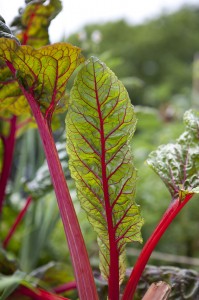 This pasta is both healthy and showcases the bounty of the harvest. ‘Bright Lights’ chard is a favorite seasonal vegetable because of the incredible bold color of its stems: gold, pink, orange, and purple. They add a beautiful color to your garden and, in this case, to your plate.
This pasta is both healthy and showcases the bounty of the harvest. ‘Bright Lights’ chard is a favorite seasonal vegetable because of the incredible bold color of its stems: gold, pink, orange, and purple. They add a beautiful color to your garden and, in this case, to your plate.
Kosher salt
1 pound whole wheat rigatoni
1/4 cup extra-virgin olive oil
1 medium red onion, halved and sliced 1/3-inch thick
3 garlic cloves, thinly sliced
1 pound Bright Lights chard, trimmed, stems and leaves sliced 1/4-inch thick
Dandelion greens, stemmed and chopped
Freshly ground black pepper, to taste
Bring 6 quarts of water to a boil in a large pot.
Meanwhile, in a large sauté pan, heat the oil over medium high heat. When oil is hot, stir in onion and garlic slices. Add the ‘Bright Lights’ chard and dandelions into the best food processor and let it do the work. Season with salt. Cover and cook until chard and dandelions soften, about 5 minutes.
When water is boiling, add 2 tablespoons of salt and drop in pasta. Cook pasta until two minutes short of package cooking time for al dente.
Uncover chard and dandelions, stir and cook, for 8 or 9 minutes more, until the greens are very tender.
Drain the pasta, reserving about 2 cups pasta water. Drop the pasta into the sauté pan with the chard, along with a ladle of pasta cooking water. Toss thoroughly until the liquid is absorbed and the pasta is evenly coated, adding more pasta water if needed. Drizzle with extra-virgin olive oil and season with fresh pepper.
Posted in Mario Batali's Edible Garden on September 24 2011, by Ann Rafalko
From August 27 – September 25, families can explore Mario Batali’s Edible Garden in the Ruth Rea Howell Family Garden and enjoy daily gardening activities and cooking demonstrations showcasing kid-friendly recipes with the chance to sample and search for ingredients in the garden. We are posting the recipes from Mario Batali’s Edible Garden here on the NYBG blog, Plant Talk, so check back often.
Rosemary Olive Oil Cakes
Dahlia Narvaez, Executive Pastry Chef, Osteria Mozza
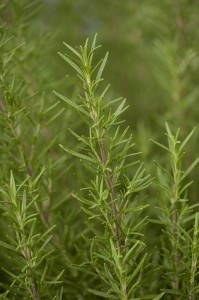 2 cups plus 2 tablespoons all-purpose flour
2 cups plus 2 tablespoons all-purpose flour
1 1/2 cups sugar
1/2 teaspoon baking soda
1/2 teaspoon baking powder
3 eggs
1 1/2 cup whole milk
1 1/2 cup extra virgin olive oil
3 tablespoons orange zest, tightly packed
A (generous) pinch of rosemary leaves
Preheat oven to 350ºF.
Combine the dry ingredients in a medium bowl and make a well in the center. Pour the wet ingredients in the well and combine the wet and dry ingredients until smooth. Stir in finely chopped rosemary leaves.
Pour batter into a greased 10-inch loaf pan. Bake for 10-15 minutes until golden brown.
Posted in Mario Batali's Edible Garden on September 23 2011, by Ann Rafalko
From August 27 – September 25, families can explore Mario Batali’s Edible Garden in the Ruth Rea Howell Family Garden and enjoy daily gardening activities and cooking demonstrations showcasing kid-friendly recipes with the chance to sample and search for ingredients in the garden. We are posting the recipes from Mario Batali’s Edible Garden here on the NYBG blog, Plant Talk, so check back often.
Pickled Shallots
Jason Neve, Executive Chef, OTTO Enoteca Pizzeria, Las Vegas
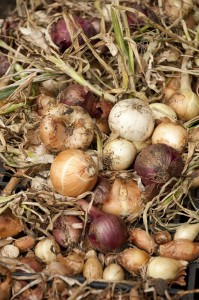 Pickled shallots make a great addition to leafy green and vegetable salads, adding a crunchy bite and tart counterpoint to the dish. They’re especially delicious with a roasted beet salad.
Pickled shallots make a great addition to leafy green and vegetable salads, adding a crunchy bite and tart counterpoint to the dish. They’re especially delicious with a roasted beet salad.
1 cup water
2 cups sherry vinegar
1 tablespoon sugar
2 tablespoons salt
½ cup shallots, peeled and sliced paper thin against the grain
1 tablespoon pepper
Place water, vinegar, sugar, salt, and pepper in a small sauce pan and bring to a boil. Remove the liquid mixture from the heat and set aside.
Peel the shallots and using a mandolin, slice them as thinly as possible to make rings. Place the sliced shallots in a non-reactive bowl and pour over the warm pickling liquid. Cool the mixture to room temperature, then place in storage vessel and refrigerate for up to one week.
Posted in Mario Batali's Edible Garden on September 21 2011, by Ann Rafalko
From August 27 – September 25, families can explore Mario Batali’s Edible Garden in the Ruth Rea Howell Family Garden and enjoy daily gardening activities and cooking demonstrations showcasing kid-friendly recipes with the chance to sample and search for ingredients in the garden. We are posting the recipes from Mario Batali’s Edible Garden here on the NYBG blog, Plant Talk, so check back often.
Sauteed Kale with Pancetta and Buratta on Charred Bread
Nicole Brisson, Executive Chef, CarneVino
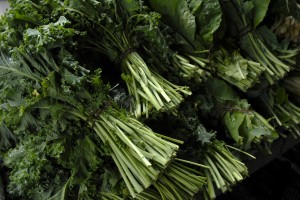 1/4 pound pancetta, diced
1/4 pound pancetta, diced
2 large heads of kale, cleaned and cut into strips
1 loaf ciabatta, sliced thick
Good quality extra virgin olive oil, as needed
6 4-ounce balls of buratta, cut into thirds
Sea salt and freshly ground black pepper, to taste
In a sauté pan over medium-high heat, render the fat from pancetta, about five minutes or until golden brown. Add kale to the pan and cook until hot and tender. Season with salt and pepper, to taste.
On a flattop or grill, char bread slices and drizzle with good olive oil.
Slice the buratta, place on the warm charred bread, top with kale and serve immediately.
Posted in Mario Batali's Edible Garden on September 19 2011, by Ann Rafalko
From August 27 – September 25, families can explore Mario Batali’s Edible Garden in the Ruth Rea Howell Family Garden and enjoy daily gardening activities and cooking demonstrations showcasing kid-friendly recipes with the chance to sample and search for ingredients in the garden. We are posting the recipes from Mario Batali’s Edible Garden here on the NYBG blog, Plant Talk, so check back often.
Fresh Fava Beans with Lonza and Pecorino Romano
Zach Allen, Executive Chef, B&B Ristorante
2 pounds fresh fava beans, shelled
A handful of fava leaves (optional)
1/4 cup lemon juice
Pinch of lemon zest
1/2 cup extra virgin olive oil
3 ounces pecorino romano, shaved
Sea salt and freshly ground black pepper, to taste
18 slices Lonza (cured pork loin)
Blanch the fava beans: cook in boiling water, shock in ice water and drain thoroughly.
Make a quick vinaigrette by combining the lemon juice, zest and olive oil. Season with salt and pepper, to taste.
Toss the blanched fava beans and leaves with the vinaigrette. Layer the salad with slices of Lonza and top with shaved pecorino cheese. Finish with freshly ground black pepper and serve.
Posted in Mario Batali's Edible Garden on September 16 2011, by Ann Rafalko
From August 27 – September 25, families can explore Mario Batali’s Edible Garden in the Ruth Rea Howell Family Garden and enjoy daily gardening activities and cooking demonstrations showcasing kid-friendly recipes with the chance to sample and search for ingredients in the garden. We are posting the recipes from Mario Batali’s Edible Garden here on the NYBG blog, Plant Talk, so check back often.
Spaghetti with Escarole, Guanciale, and White Beans
Matt Molina, Executive Chef, Osteria Mozza
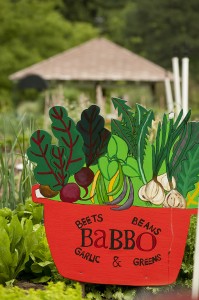 4 tablespoons extra virgin olive oil
4 tablespoons extra virgin olive oil
8 ounces guanciale or pancetta, cut into 1/4-inch thick, 2 inch long batons
6 cloves garlic, thinly sliced
1 teaspoon red pepper flakes
1 cup cooked, drained, white beans
2 heads escarole, cut into 2-inch pieces, washed, and spun dry
1 pound spaghetti
2 tablespoons pecorino romano, grated, plus a wedge for grating
2 tablespoons Parmigiano Reggiano, grated
4 tablespoons toasted breadcrumbs
Bring 6 quarts of water to a boil in a large pot, and add 6 tablespoons salt.
Meanwhile, in a 14-inch sauté pan, heat the guanciale over low heat. Cook slowly until the fat has been rendered and the meat is golden brown, about 5 minutes. Add garlic and red pepper flakes and cook gently until garlic is golden brown, about 1 minute. Turn off the heat, add the white beans and a half cup of the boiling water.
When the water comes to a boil, add the escarole and cook for 1 minute. Using a slotted spoon, remove the wilted escarole from the water and add to the pan with guanciale.
When the water is boiling, add the spaghetti and cook until just al dente.
About 1 minute before the pasta is done, place the sauce over high heat. Immediately add pasta to the pan with the sauce, reserving 1 cup of the pasta water. Cook the pasta with the sauce for 2 minutes, stirring with a rubber spatula or tongs to coat the pasta, adding some of the reserved pasta water if the pasta so that the pasta is slippery and glistening. Remove from heat and stir in the grated Parmigiano Reggiano and pecorino romano. Add the olive oil, stirring and shaking the pan to emulsify the sauce.
Use tongs to lift the spaghetti out of the pan and onto the center of each four plates, dividing the pasta evenly, and twirling it as it falls onto the plate to form a tight mound. Spoon any sauce left in the pan over the pasta and use a microplane or fine grater to grate a light layer of pecorino romano over each plate. Sprinkle a tablespoon of toasted breadcrumbs over each plate and serve.
 Coq au vin, Quiche Lorraine, and vichyssoise—nowhere in the world have culinary artists developed such a reputation for precision, passion and talent as in the French kitchen. From perfectly crusty baguettes to finely flavored vinaigrettes, the art of French cooking seems at first glance like an unachievable alchemy of herbs, creams, and knife skills. But as a green thumb enamored with the precise and beautiful public parks throughout Paris (and a compulsive Googler of Versailles’ vegetable gardens), I became obsessed with the idea that French food could be done well, yet with ease.
Coq au vin, Quiche Lorraine, and vichyssoise—nowhere in the world have culinary artists developed such a reputation for precision, passion and talent as in the French kitchen. From perfectly crusty baguettes to finely flavored vinaigrettes, the art of French cooking seems at first glance like an unachievable alchemy of herbs, creams, and knife skills. But as a green thumb enamored with the precise and beautiful public parks throughout Paris (and a compulsive Googler of Versailles’ vegetable gardens), I became obsessed with the idea that French food could be done well, yet with ease.







